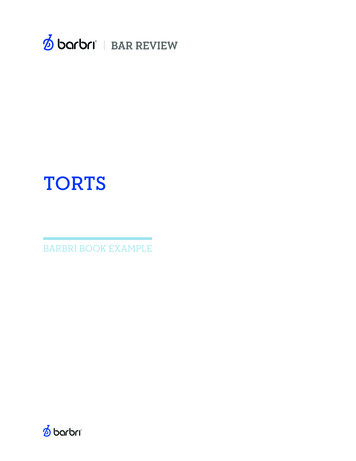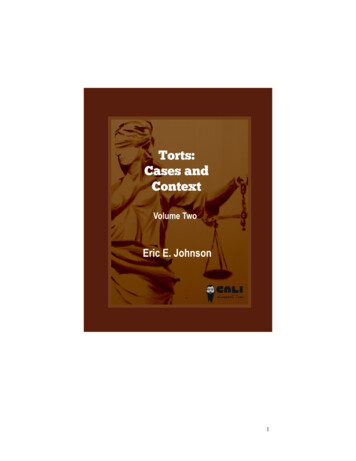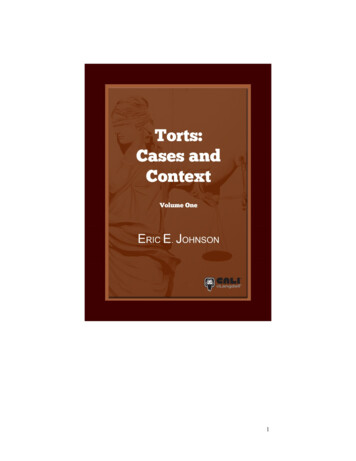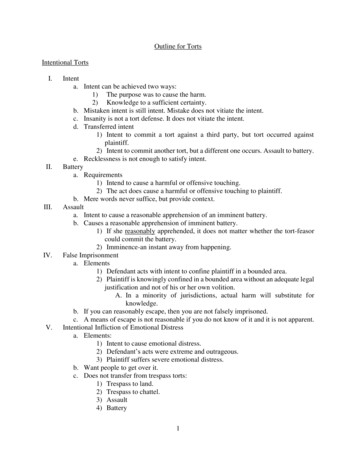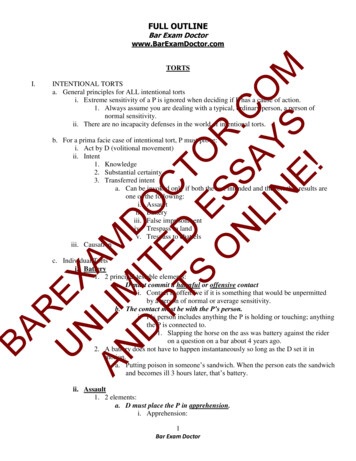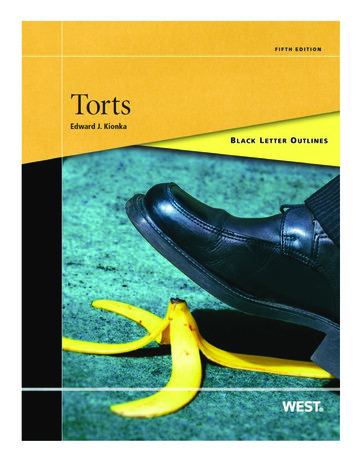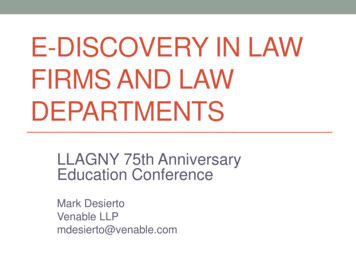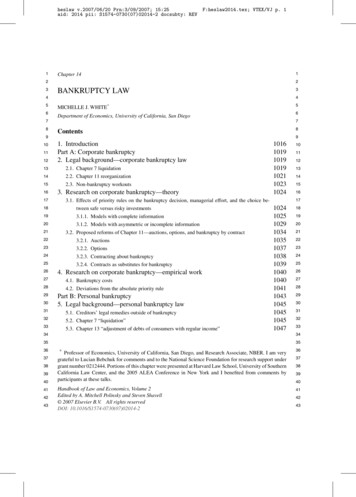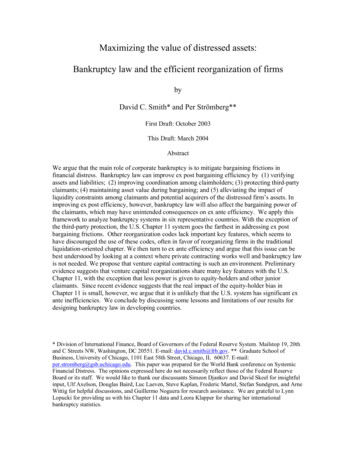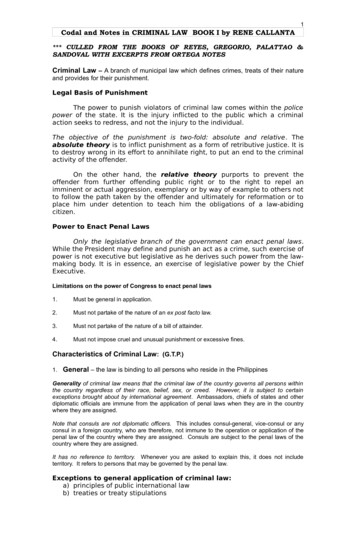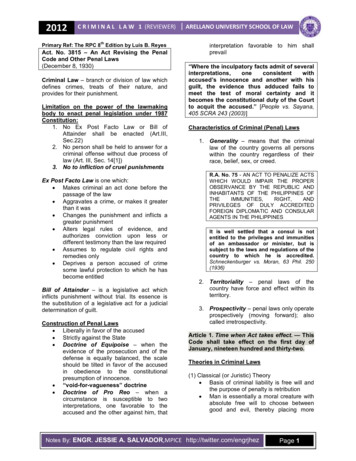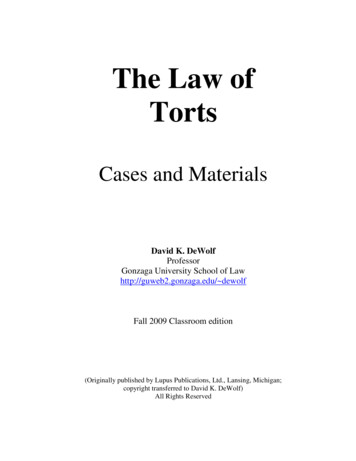
Transcription
The Law ofTortsCases and MaterialsDavid K. DeWolfProfessorGonzaga University School of Lawhttp://guweb2.gonzaga.edu/ dewolfFall 2009 Classroom edition(Originally published by Lupus Publications, Ltd., Lansing, Michigan;copyright transferred to David K. DeWolf)All Rights Reserved
COPYRIGHT 1999, 2009Printed in the United States of AmericaAll rights reserved
TABLE OF CONTENTSINTRODUCTION: AN OVERVIEW OF TORTLAW . 7§ A. THE NATURE OF TORT LAW . VII§ B. THE STRUCTURE OF THIS BOOK . VII§ C. THE SELECTION OF CASE MATERIALS .XProblem . xRAILROAD CO. v. STOUT . xUNITED ZINC & CHEMICAL CO. v.BRITT . xivQuestions and Notes . xviCHAPTER 1 ESTABLISHING A BREACH OFDUTY . 2STEVENS v. BOSTON ELEVATED RY. CO. 29Questions and Notes . 303. Establishing Vicarious Liability(Respondeat Superior) . 31HAYES v. FAR WEST SERVICES, INC. . 31Questions and Notes . 32§ B. STRICT LIABILITY . 331. The Distinction Between Strict Liabilityand Negligence . 34HELLING v. CAREY . 34Questions and Notes . 372. When Is Strict Liability Imposed? . 38a. Abnormally Dangerous Activities . 38INTRODUCTION . 2SIEGLER v. KUHLMAN . 38BIERMAN v. CITY OF NEW YORK.3Questions and Notes . 42b. Invasion of Property Rights Nuisance . 43Notes and Questions . 4HAMMONTREE v. JENNER .51. The Standard of Reasonable Care InGeneral . 7LUSSAN v. GRAIN DEALERS MUTUALINSURANCE COMPANY .7FLETCHER v. RYLANDS . 43FLETCHER v. RYLANDS . 45RYLANDS v. FLETCHER . 48Questions and Notes . 48VAUGHN v. MENLOVE .8BOHAN v. PORT JERVIS GAS LIGHT CO. 49BOOMER v. ATLANTIC CEMENT CO. 51Questions and Notes . 9Questions and Notes . 54ADAMS v. BULLOCK .9SPUR INDUSTRIES v. DEL E. WEBBDEVELOPMENT CO. . 54a. The "Reasonable Person\ . 8Questions and Notes . 10b. "Customizing" the Standard of theReasonable Person . 10ROBINSON v. LINDSAY .10Questions and Notes . 12c. Efficiency . 13Questions and Notes . 56c. Animals. 56WILLIAMS v. JOHNSON . 56d. Statutory Strict Liability . 58COOK v. WHITSELL-SHERMAN . 58UNITED STATES v. CARROLL TOWING 13Notes and Questions . 62Questions and Notes . 14Questions and Notes . 15a. Juror Experience. 15b. The Use of Industry Custom . 15CHAPTER 2PROXIMATE CAUSE . 63BENNETT v. LONG ISLAND R. CO. .15T.J. HOOPER .17Questions and Notes . 18c. Statutory Violations . 18MARTIN v. HERZOG .18TEDLA v. ELLMAN .21Questions and Notes . 22d. Res Ipsa Loquitur . 24MURPHY v. MONTGOMERY ELEVATORCO.24Questions and Notes . 25e. Evidence of Defendant's Safety Policies . 26HYJEK V. ANTHONY INDUSTRIES .26INTRODUCTION . 63MITCHELL v. GONZALEZ . 63Questions and Notes . 74§ A. BUT-FOR CAUSATION (CAUSE-IN-FACT) . 741. The Traditional Burden of Proof . 74HULL v. MERCK & CO. . 74Questions and Notes . 75REYNOLDS v. TEXAS & PACIFICRAILWAY CO. . 762. Modifying the But-For CausationRequirement . 76a. Excusable Inability to Identify theDefendant . 76SUMMERS v. TICE . 76SINDELL v. ABBOTT LABORATORIES . 79
ivINTRODUCTIONQuestions and Notes. 90BROWN v. SUPERIOR COURT . 91Questions and Notes. 92b. Loss of a Chance . 92BROWN v. SUPERIOR COURT . 92Questions and Notes. 94BROWN v. SUPERIOR COURT . 94Questions and Notes. 99c. Multiple Redundant Causes: The"Substantial Factor" Test . 99PURCELL v. ASBESTOS CORPORATION,LTD. 99§ B. LEGAL CAUSE: POLICY CONSIDERATIONSPRECLUDING LIABILITY . 103BERRY v. SUGAR NOTCH . 103Questions and Notes. 1042. Superseding Tortfeasors: Breaking theChain of Causation . 104CROWE V. GASTON . 104Questions and Notes. 109LINEY v. CHESTNUT MOTORS . 109Questions and Notes. 110ROSS v. HARTMAN. 110Questions and Notes. 1123. Remote and Indirect Results of NegligentConduct . 112PALSGRAF v. LONG ISLAND R. CO . 112Questions and Notes. 118KINSMAN TRANSIT CO . 119Questions and Notes. 123INTRODUCTION . 124Jaffe, Damages for Personal Injury: TheImpact of Insurance . 124§ A. TYPES OF RECOVERABLE DAMAGES. 1251. Property Damage. 125McCURDY v. UNION PAC. R.R. . 1252. "Economic" Losses. 125a. Lost Wages . 125O'SHEA v. RIVERWAY TOWING . 125Questions and Notes. 130b. Medical Expenses . 1303. "Non-economic" Damages - Pain andSuffering . 130MORSE v. AUBURN AND SYRACUSERAILROAD CO. . 130Questions and Notes. 131SPADE v. LYNN & B.R. CO. 132Questions and Notes. 133JOHNSON v. STATE OF NEW YORK . 134Questions and Notes. 136STEINHAUSER v. HERTZ CORPORATION. 136Questions and Notes. 1374. Punitive Damages . 138MORAN v. JOHNS-MANVILLE SALESCORPORATION . 138Questions and Notes . 140GRIMSHAW v. FORD MOTOR CO. . 140Questions and Notes . 1485. Attorneys Fees . 148Kuenzel, The Attorney's Fee: Why Not a Costof Litigation? . 148Questions and Notes . 149§ B. RELATED PARTIES: WHO ELSE IS ENTITLEDTO COMPENSATION? . 1491. Wrongful Death . 149MORAGNE v. STATES MARINE LINES 149FIRST NATIONAL BANK OF MEADVILLEv. NIAGARA THERAPY MANUFACTURING CORPORATION . 154FELDMAN v. ALLEGHENY AIRLINES . 156Questions and Notes . 1602. "Wrongful Birth" and "Wrongful Life\ 160UNIVERSITY OF ARIZONA HEALTHSCIENCES CENTER v. SUPERIOR COURT. 161HARBESON v. PARKE-DAVIS . 168Questions and Notes . 1743. Bystander Injuries . 175DILLON v. LEGG . 175Questions and Notes . 178HEGEL v. McMAHON . 1794. Loss of Consortium . 185RODRIGUEZ v. BETHLEHEM STEELCORPORATION . 185Questions and Notes . 190BORER v. AMERICAN AIRLINES . 190Questions and Notes . 192§ C. THE SIZE OF DAMAGE AWARDS . 1921. How Much is Too Much (or Too Little)?192FORTMAN v. HEMCO, INC . 192Questions and Notes . 195FEIN v. PERMANENTE MEDICAL GROUP. 196Questions and Notes . 2002. Collateral Source Benefits . 201SCHONBERGER v. ROBERTS . 201Questions and Notes . 2033. The Scope of Acceptable Argument . 204BOTTA v. BRUNNER . 204Questions and Notes . 205STECKER v. FIRST COMMERCIALTRUST CO. 206PART II DEFENSES TO A PERSONAL INJURYCASE . 209Introductory Note . 210CHAPTER 4 IMMUNITY . 210
INTRODUCTIONv§ A. GOVERNMENTAL IMMUNITY . 210§ C. TOLLING OF THE LIMITATION PERIOD . 294Federal Tort Claims Act .210STRAHLER v. ST. LUKE'S HOSPITAL . 294Questions and Notes . 211LAIRD v. NELMS .211Questions and Notes . 215VANDERPOOL v. STATE .216Questions and Notes . 220§ B. FAMILY IMMUNITIES. 220HOLODOOK v. SPENCER .220Questions and Notes . 223§ C. WORKER'S COMPENSATION. 224WOLF v. SCOTT WETZEL SERVICES,INC. .224Questions and Notes . 226CHAPTER 5 CONTRIBUTORY FAULT. 228PART III MODIFICATION OF DUTYBYSTATUS AND RELATIONSHIPS . 300INTRODUCTION . 300Questions and Notes . 301§ A. THE STATUS DISTINCTIONS. 3021. Are the Status Distinctions Desirable? . 302YOUNCE v. FERGUSON . 302ROWLAND v. CHRISTIAN. 306Questions and Notes . 3092. How is the Visitor's Status Determined? 309MARKLE v. HACIENDA MEXICANRESTAURANT . 309Questions and Notes . 314§ A. THE CONTRIBUTORY NEGLIGENCE RULE. 228HOSTICK v. HALL . 315GUILFORD v. YALE UNIVERSITY . 315LI v. YELLOW CAB COMPANY OFCALIFORNIA .228Questions and Notes . 3163. An Exception for Trespassing Children 317Questions and Notes . 234§ B. ASSUMPTION OF RISK . 235OSTERMAN v. PETERS . 317HOFER v. MEYER . 319SMITH v. BAKER & SONS .235Questions and Notes . 322§ B. WHEN DOES PREMISES LIABILITY GOVERNTHE CASE? . 323Questions and Notes . 237BROWN v. SAN FRANCISCO BALL CLUB.237Questions and Notes . 238ALSTON v. BLYTHE .238KIRK v. WASHINGTON STATEUNIVERSITY .242Questions and Notes . 246§ A. OVERVIEW AND STATUTORY EXCERPTS . 247Idaho Code (1990 Supplement) .247Oregon Revised Statutes .248Uniform Comparative Fault Act .251Questions and Notes . 253§ B. JOINT AND SEVERAL LIABILITY . 253LAUBACH v. MORGAN.253Questions and Notes . 256POTTS v. AMIS . 323Questions and Notes . 325§ A. HISTORY: THE RISE AND FALL OF PRIVITY. 326WINTERBOTTOM v. WRIGHT . 326Questions and Notes . 327MACPHERSON v. BUICK MOTOR CO. 327HENNINGSEN v. BLOOMFIELD MOTORS,INC. . 329Questions and Notes . 333§ B. THE ADOPTION OF STRICT LIABILITY INTORT . 334ESCOLA v. COCA COLA BOTTLINGCOMPANY OF FRESNO . 334BOYLES v. OKLAHOMA NATURAL GASCO.257AMERICAN MOTORCYCLE ASS'N v.SUPERIOR COURT .260Questions and Notes . 335Questions and Notes . 268§ C. THE EFFECT OF SETTLEMENT . 269PHILLIPS v. KIMWOOD MACHINE CO. 337GREENMAN v. YUBA POWER PRODUCTS. 335Questions and Notes . 337WASHBURN v. BEATT EQUIPMENTCOMPANY .269Questions and Notes . 344INTRODUCTION . 275§ A. APPLYING THE CORRECT LIMITATIONPERIOD . 275§ C. THE RESTATEMENT (3D) OF TORTS(PRODUCT LIABILITY) . 350Questions and Notes . 354§ A. MEDICAL MALPRACTICE . 3551. Negligence. 355DICKENS v. PURYEAR.275§ B. ACCRUAL OF THE CAUSE OF ACTION . 283ESTATES OF HIBBARD v. GORDON, et al.283PFEIFER v. CITY OF BELLINGHAM .288BROWN v. SUPERIOR COURT . 345KNIGHT v. HAYDARY . 355Questions and Notes . 359
viINTRODUCTION2. Informed Consent . 359WACHTER v. UNITED STATES . 359Questions and Notes. 367§ B. OTHER FORMS OF PROFESSIONALMALPRACTICE . 368BUCH v. AMORY MANUFACTURING CO. 369Questions and Notes. 370TARASOFF v. REGENTS OF UNIVERSITYOF CALIFORNIA. 370Questions and Notes. 376BROWN v. UNITED STATES . 377Questions and Notes. 381PART IV INTENTIONAL TORTS . 387CHAPTER 12 INTENTIONAL TORTS: THEPRIMA FACIE CASE . 388INTRODUCTION . 388Restatement (2d) of Torts . 388§ A. BATTERY AND ASSAULT . 390§ B. FALSE IMPRISONMENT. 395MOORE v. PAY'N SAVE CORPORATION. 395Questions and Notes. 398§ C. INTENTIONAL INFLICTION OF EMOTIONALDISTRESS (OUTRAGE) . 398CORRIGAL v. BALL AND DODDFUNERAL HOME, INC . 398§ A. CONSENT . 400STRAWN v. INGRAM . 400MILLER v. BENNETT . 401Questions and Notes. 402§ B. DEFENSE OF SELF . 403COTE v. JOWERS . 403§ C. DEFENSE OF OTHERS. 409YOUNG v. WARREN. 409§ D. DEFENSE OF PROPERTY . 411C.I.T. CORPORATION v. BREWER . 411KATKO v. BRINEY . 413Questions and Notes . 416§ E. STATUTORY PRIVILEGE . 416APPENDIX A. THE PROCEDURAL HISTORYOF A SIMPLE CASE . A.1APPENDIX B. INSURANCE . A.16APPENDIX C. FORMS OF ACTION . A.19
Introduction:An Overview of Tort Law§ A. The Nature of Tort LawTort law is basically about collisions. Oftenthe collision is literal, as where two cars collide inan intersection,1 or a defective Coke bottleexplodes in the hand of a waitress,2 but evenwhere the collision is less literal it is no less real.For example, in defamation (libel and slander)cases,3 plaintiffs sue to recover for injury to theirreputations. Tort law must resolve the conflictbetween competing claims of the individual'sinterest in his reputation and the public's interest infree expression. Just as cars on the highwayusually pass one another without incident, sonewspapers and individuals can - usually - carryon their respective activities in harmony.Occasionally, however, collisions occur andsomeone is hurt. When that happens we turn totort law to decide who must pay for the injury: isthe injured party entitled to have the party thatcaused his injury compensate him, or should theloss "lie where it falls"4?What makes tort law so interesting (and at thesame time so difficult) is that there are no absoluteformulas by which such questions are resolved.The rules of tort law are rough approximations ofthe balance our society wants to strike betweencompeting values, and the "correct" decisionfrequently depends upon the facts of the particularcase. For example, we make automobile driversliable for the injuries they cause, but only whenthey are "at fault," or negligent. Manufacturers, bycontrast, are liable for the injuries caused by adefective product, even if they have exercised allreasonable care. Newspapers, to take another1example, are not liable for injuries to thereputation of "public figures," even the newspaperacts negligently, so long as it does not exhibit"reckless disregard" for the probable falsity ofwhat they are publishing.The primary problem in striking the properbalance lies in determining the standard forimposing liability. Should the defendant be liableirrespective of negligence (strict liability); liable ifnegligent; or liable only his behavior is even moreculpable than mere negligence (e.g., intentionaltorts)? In addition to the thorny questions aboutwhen to impose liability, tort law must alsoaddress issues of how to determine whether aplaintiff's harm was caused by a defendant'sconduct, how to calculate the proper amount ofdamages, the availability of special immunities ordefenses to liability, etc.§ B. The Structure of this BookThis book is divided into six parts, each ofwhich covers a distinct set of issues that are raisedin the administration of tort law. Part I, Personal Injury: The PrimaFacie Case, discusses what is usually thoughtof as the plaintiff's "prima facie" case in atypical tort suit: what must the plaintiff provein order to recover? Just a moment ago I saidthat the question of whether to shift theburden to the defendant depends uponwhether the injured party was "[1] entitled tohave the party that [2] caused his injury[3] compensate him." These three elementsmake up the building blocks of what aplaintiff must prove in a typical tort case, andthey are discussed in Chapters One, Two andThree respectively.5Li v. Yellow Cab, infra Chapter Five.2Escola v. Coca Cola Bottling Co., infra ChapterEight.34This subject is covered in Chapter Twelve."The general principle of our law is that loss fromaccident must lie where it falls, and this principle is notaffected by the fact that a human being is the instrument ofmisfortune." OLIVER WENDELL HOLMES, THE COMMONLAW 88 (1881).5A tort case is typically described as consisting ofan analysis of four elements: duty, breach, cause, anddamages. Harbeson v. Parke-Davis, infra Chapter Three.This text follows this general approach with one majorexception: Duty and breach are classed together asessentially a single question. Part III discusses in greaterdetail the question of how to determine what kind of dutythe defendant owes to the plaintiff. Because the "duty"question has confused generations of lawyers, not to
viiiINTRODUCTION Chapter 1, Establishing a Breachof Duty, examines what the plaintiff mustprove about the defendant's conduct toentitle him to be compensated. As notedabove, the most common standard is thatof reasonable care, or to put it in thenegative mode, whether or not thedefendant was negligent. However, incertain kinds of cases liability can beimposed on a "no-fault" or "strictliability" basis. Chapter 2, Causation, considersa separate problem: if we have decidedthat the defendant breached a duty heowed, and thus should in fairness pay forthe injuries that his conduct causes theplaintiff, how do we know that thedefendant's breach of duty (rather thansome other force(s)) caused the injury? Inthe vast majority of cases causation isobvious, but where it is in doubt theanalysis is complex indeed. Chapter 3, Damages, examineswhat kinds of damages can be recovered,who can recover them, and how a dollarvalue is assigned to the plaintiff's loss. Part II, Defenses to a Personal InjuryCase, looks at the tort case from the defendant'spoint of view. Even if the plaintiff has met eachof the three elements of the prima facie case,other policy considerations may intervene toallow the defendant to avoid liability or reducethe amount of liability. Chapter 4, Immunity, looks atdoctrines that exempt certain classes ofdefendants from liability. It also looks at themodification or abandonment of suchdoctrines through statutory waiver andcaselaw restriction. Chapter 5, Contributory Fault,considers the principles that allow amention law students (and rarely helps to solve a problemto boot), this text starts from the facts of a situation andasks the question "Does the defendant's conduct in thiscase constitute a breach of duty?" It might seem easier tostart with the question, "What dut(ies) did the defendantowe the plaintiff?" and then proceed to determine whetherthat duty is breached. But modern commentators seem toapprove of a formulation of negligence law in which thereis “a default duty of reasonable care with regard to causingphysical harm.” W. Jonathan Cardi & Michael D. Green ,Duty Wars, 81 S. CAL. L. REV. 671 (2008)defendant to escape or reduce his liabilitybecause the plaintiff was at least in partresponsible for his own injury. Chapter 6, Multiple Tortfeasors, isconcerned with cases where the plaintiff'sinjury was caused by more than onedefendant. In such cases the court mustdecide how the responsibility for the injuryis to be allocated, and in particular whetherto make one defendant responsible for otherdefendants who may or may not be able topay their fair share. In addition, courts mustdecide how to handle cases where one partysettles for only part of the liability and theplaintiff pursues his claim against anotherdefendant. Chapter 7, Statutes of Limitation,deals with a familiar problem: what happenswhen the plaintiff waits too long to file hisclaim? How does the court measure theamount of time that the plaintiff is given tofile a claim, and what circumstances willallow an exception to the rule? Part III, Modification of Duty byStatus and Relationships, returns toexamine the origin and limiting principlesthat accompany the duty to use reasonablecare. In particular, it considers the numerouscases in which the defendant's duty of careto the plaintiff is affected by a contractualrelationship that exists between them.Courts must decide the significance of thefact that in many cases the parties have theopportunity to shape the transaction - toshift the entitlements - before the risk ofinjury is created. Chapter 8, Premises Liability,concerns a common transaction: wherethe defendant has permitted the plaintiffto use his land for some purpose. Mostcourts make the defendant's duty (andsubsequent tort liability) depend upon thenature of the relationship between them:whether it is business, social, ornonconsensual. Chapter 9, Product Liability,considers an analogous problem: wherethe plaintiff has agreed to buy thedefendant's product, and defendant hasagreed to sell it, what duties has the selleraccepted with respect to the safety of theproduct? What obligations has the buyeraccepted? RAILROAD CO. V. STOUTChapter10,Professional
INTRODUCTIONNegligence, deals with yet another set ofrelated parties: the provider and theconsumer of professional services, suchas medicine, law, accounting, etc. Whilethe standard of reasonable care works as agood baseline for predicting liability,there are peculiarities in the professionalcontext that require special attention.While most of this chapter focuses on themedical context, since the injuries thereare most spectacular, tort remedies arepursued in an increasing number ofprofessional specialties. Chapter 11, Rescuers, JustifiableReliance, and the Extension of Duty toRemote Plaintiffs, deals with one of thelaw's most difficult subjects: when toimpose upon someone a duty to usereasonable care. This chapter starts withthe premise that, ordinarily, tort liabilitycan only be predicated upon the defendanthaving acted in a way that caused theplaintiff's injury. In other words, thefailure to act ordinarily creates noliability. However, in some cases thedefendant may have assumed a duty toprotect the plaintiff from harm causedfrom some external source (e.g. acaseworker who intervenes in a childabuse situation, or an ambulance serviceresponding to an emergency call). Thereare particularly difficult questions abouthow far liability should be extended. Part IV, Intentional Torts, considersthose cases - relatively rare in terms of theeveryday practice of law, but fundamental to anunderstanding of the history of tort law - wherethe defendant intentionally causes injury to theplaintiff. Chapter 12, Intentional Torts: ThePrima Facie Case, analyzes the burden ofproof for the plaintiff in much the same waythat we did in the negligence cases.However, because the requirements aredifferent, and more technical in nature,close attention is paid to the criteriaestablished in the principal authority forsuch cases, the Restatement of Torts.ixlose the case because of the application of aprinciple denying recovery. Part V, Harm to Non-PhysicalInterests, treats those cases where the plaintiffsustains an injury to an interest other thanphysical well-being. For example, the plaintiffmay have suffered injury to reputation(defamation), or the defendant may haveinvaded the plaintiff's interest in privacy, or thedefendant caused harm to the plaintiff's businessinterests or his right to be free from wrongfullitigation. Chapter 14, Defamation, discussesthe cases where the plaintiff's right to hisreputation is injured by the defendant'suse (or abuse) of the first amendmentright to speak one's mind. Chapter 15, Privacy, is a topic relatedto defamation; but it involves an injury toa different interest - the right to be letalone, usually by some type of mediaexposure, but occasionally by otherintrusions. Chapter 16, Damage to BusinessInterests, addresses situations where thedefendant caused a business or propertyloss, for ex
An Overview of Tort Law § A. The Nature of Tort Law Tort law is basically about collisions. Often the collision is literal, as where two cars collide in an intersection,1 or a defective Coke bottle explodes in the hand of a waitress,2 but eve
